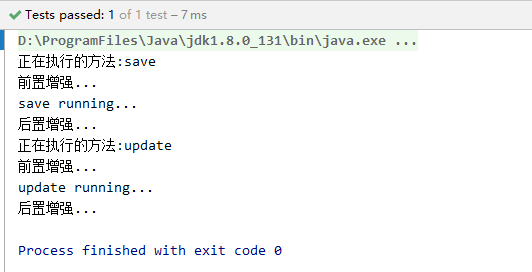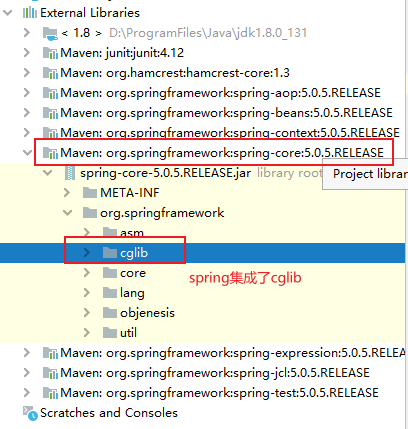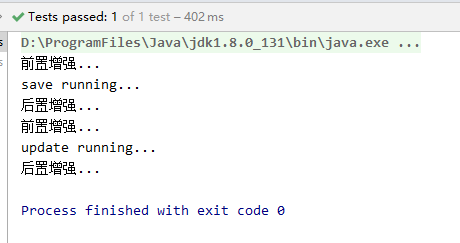Spring动态代理模式原理 Spring中AOP概念与两种动态代理模式原理详解
HouFei-Liu 人气:01.概念
1.AOP技术简介
AOP 为Aspect Oriented Programming 的缩写,意思为面向切面编程,是通过预编译方式和运行期动态代理实现程序功能的统一维护的一种技术。
AOP 是 OOP 的延续,是软件开发中的一个热点,也是Spring框架中的一个重要内容,是函数式编程的一种衍生范型。利用AOP可以对业务逻辑的各个部分进行隔离,从而使得业务逻辑各部分之间的耦合度降低,提高程序的可重用性,同时提高了开发的效率。
2.AOP的优势
作用:在程序运行期间,在不修改源码的情况下对方法进行功能增强优势:减少重复代码,提高开发效率,并且便于维护
3.Spring AOP术语
Spring 的 AOP 实现底层就是对上面的动态代理的代码进行了封装,封装后我们只需要对需要关注的部分进行代码编写,并通过配置的方式完成指定目标的方法增强。在正式讲解 AOP 的操作之前,我们必须理解 AOP 的相关术语,常用的术语如下:
Target(目标对象):代理的目标对象Proxy (代理):一个类被 AOP 织入增强后,就产生一个结果代理类Joinpoint(连接点):所谓连接点是指那些被拦截到的点。在spring中,这些点指的是方法,因为spring只支持方法类型的连接点.(可能被增强的方法)Pointcut(切入点):所谓切入点是指我们要对哪些 Joinpoint 进行拦截的定义(被增强的方法)Advice(通知/ 增强):所谓通知是指拦截到 Joinpoint 之后所要做的事情就是通知(对目标对象增强的方法)Aspect(切面):是切入点和通知(引介)的结合(目标方法+增强=切面)Weaving(织入):是指把增强应用到目标对象来创建新的代理对象的过程。 spring采用动态代理织入,而AspectJ采用编译期织入和类装载期织入.(一个动作,切点和通知结合的过程=织入)
4.AOP 开发明确的事项
需要编写的内容 编写核心业务代码(目标类的目标方法)编写切面类,切面类中有通知(增强功能方法)在配置文件中,配置织入关系,即将哪些通知与哪些连接点进行结合 AOP 技术实现的内容 Spring 框架监控切入点方法的执行。一旦监控到切入点方法被运行,使用代理机制,动态创建目标对象的代理对象,根据通知类别,在代理对象的对应位置,将通知对应的功能织入,完成完整的代码逻辑运行。 AOP 底层使用哪种代理方式 在 spring 中,框架会根据目标类是否实现了接口来决定采用哪种动态代理的方式。
2.AOP底层实现
实际上, AOP 的底层是通过 Spring 提供的的动态代理技术实现的。在运行期间, Spring通过动态代理技术动态的生成代理对象,代理对象方法执行时进行增强功能的介入,在去调用目标对象的方法,从而完成功能的增强。
1.AOP 的动态代理技术:
常用的动态代理技术
- JDK 代理 : 基于接口的动态代理技术
- cglib 代理:基于父类的动态代理技术

2.基于jdk的动态代理代码
//---------接口1------------
package com.itspring.proxy.jdk;
public interface TargetInterface1 {
void save();
}
//---------接口2------------
package com.itspring.proxy.jdk;
public interface TargetInterface2 {
void update();
}
//---------接口1,接口2实现类(目标类)------------
package com.itspring.proxy.jdk;
//目标类(被增强的类)
public class Target implements TargetInterface1 ,TargetInterface2{
public void save() {
System.out.println("save running...");
}
public void update() {
System.out.println("update running...");
}
}
//---------通知类(方法增强类)------------
package com.itspring.proxy.jdk;
//通知类(增强类)
public class Advice {
public void before() {
System.out.println("前置增强...");
}
public void afterRunning() {
System.out.println("后置增强...");
}
}
//---------测试代码------------
package com.itspring.proxy.jdk;
import org.junit.Test;
import java.lang.reflect.InvocationHandler;
import java.lang.reflect.Method;
import java.lang.reflect.Proxy;
public class ProxyTest {
@Test
public void test1() {
final Target target = new Target();
final Advice advice = new Advice();
//返回值就是动态生成的代理对象
TargetInterface1 proxy1 = (TargetInterface1) Proxy.newProxyInstance(
target.getClass().getClassLoader(), //目标类的类加载器
target.getClass().getInterfaces(), //目标类实现的接口(可能有多个)
new InvocationHandler() {
//调用代理对象的任何方法,实质上都是调用invoke方法
public Object invoke(Object proxy, //代理对象
Method method, //目标方法对象
Object[] args //目标方法的参数
) throws Throwable {
System.out.println("正在执行的方法:" + method.getName());
advice.before(); //前置增强
Object invoke = method.invoke(target, args); //执行目标方法
advice.afterRunning(); //后置增强
return invoke;
}
}
);
proxy1.save();
//返回值就是动态生成的代理对象
TargetInterface2 proxy2 = (TargetInterface2) Proxy.newProxyInstance(
target.getClass().getClassLoader(), //目标类的类加载器
target.getClass().getInterfaces(), //目标类实现的接口(可能有多个)
new InvocationHandler() {
//调用代理对象的任何方法,实质上都是调用invoke方法
public Object invoke(Object proxy, //代理对象
Method method, //目标方法对象
Object[] args //目标方法的参数
) throws Throwable {
System.out.println("正在执行的方法:" + method.getName());
advice.before();
Object invoke = method.invoke(target, args); //执行目标方法
advice.afterRunning();
return invoke;
}
}
);
proxy2.update();
}
}

3.基于cglib的动态代理代码
cglib是第三方的库,spring集成了cglib.


//---------目标类-------------
package com.itspring.proxy.cglib;
import com.itspring.proxy.jdk.TargetInterface1;
import com.itspring.proxy.jdk.TargetInterface2;
//目标类(被增强的类)
public class Target {
public void save() {
System.out.println("save running...");
}
public void update() {
System.out.println("update running...");
}
}
//---------通知类(增强类)-------------
package com.itspring.proxy.cglib;
//通知类(增强类)
public class Advice {
public void before() {
System.out.println("前置增强...");
}
public void afterRunning() {
System.out.println("后置增强...");
}
}
//---------测试代码-------------
package com.itspring.proxy.cglib;
import com.itspring.proxy.jdk.TargetInterface1;
import com.itspring.proxy.jdk.TargetInterface2;
import org.junit.Test;
import org.springframework.cglib.proxy.Enhancer;
import org.springframework.cglib.proxy.MethodInterceptor;
import org.springframework.cglib.proxy.MethodProxy;
import java.lang.reflect.InvocationHandler;
import java.lang.reflect.Method;
import java.lang.reflect.Proxy;
public class ProxyTest {
@Test
public void test1() {
//目标对象
final Target target = new Target();
//增强对象
final Advice advice = new Advice();
//基于cglib生成动态代理对象
//1.创建增强器
Enhancer enhancer = new Enhancer();
//2.创建父类
enhancer.setSuperclass(Target.class);
//3.设置回调
enhancer.setCallback(new MethodInterceptor() {
public Object intercept(Object proxy, //代理对象
Method method, //目标方法
Object[] objects, //目标方法的参数
MethodProxy methodProxy) //目标方法的代理
throws Throwable {
//前置增强
advice.before();
//目标方法
Object invoke = method.invoke(target, objects);
//后置增强
advice.afterRunning();
return invoke;
}
});
//4.生成代理对象
Target target1 = (Target) enhancer.create();
//5.测试
target1.save();
target1.update();
}
}

总结
加载全部内容